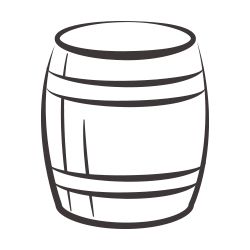The French elegance expressed by Sicilian Terroir
Camelot
Sicilia D.O.C.
Cabernet Sauvignon, Merlot
Camelot’s elegance is the result of lengthy research, over more than 20 years, which Firriato has dedicated to guaranteeing the best climate and soil conditions for growing Merlot and Cabernet Sauvignon. The Baglio Sorìa vineyards, located at an altitude of 120metres above sea level, with their vicinity to the Trapani coast and the uniqueness of their terroir, contribute to determining the ideal conditions for the cultivation of these two vines. The red marl in its soils allows the earth, during the hotter months, to remain compact and not crack. This maintains constant humidity in the subsoil which favours a balance between the ripened fruit’s sugar levels and its polyphenols, which is harder to achieve in hotter climates. Ageing for 12 months in French oak barriques gives the wine incomparable aromatic elegance and flavour.
Camelot’s elegance is the result of lengthy research, over more than 20 years, which Firriato has dedicated to guaranteeing the best climate and soil conditions for growing Merlot and Cabernet Sauvignon. The Baglio Sorìa vineyards, located at an altitude of 120metres above sea level, with their vicinity to the Trapani coast and the uniqueness of their terroir, contribute to determining the ideal conditions for the cultivation of these two vines.
- Appellation: DOC Sicilia
- Vine: Cabernet Sauvignon and Merlot
- Terroir: hilly
- Soil: clayey soils with red marlstones presence
- Exposure: sud (235 mt. a.s.l)
Production Area
Baglio Sorìa

Cultivation of international varieties is concentrated on the Baglio Sorìa Estate, where the terroir stands out for the mix of clays and red marls in its soil. These are characteristics of areas most dedicated to wine-growing and producing.

Firriato’s Blend
The exceptional combination of the humidity in the subsoil, and the hotter climate of the summer months in Sicily, favours the elegant characteristic notes that make the pleasure of drinking Camelot so unique. The Cabernet Sauvignon and Merlot grapes grown on the Baglio Sorìa Estate are characteristically lower in pyrazines. This trait creates a natural condition that gives Camelot elegance and smoothness, limiting to a minimum the prevalent vegetable notes with nuances of red pepper and tomato leaf. As ever, it is the terroir that determines the elegant development of this Bordeaux vine in Sicilian soil. The relationship between the microclimate and the soil creates the ideal conditions for gradual ripening of the grapes, which influences their complete aromatic development. Camelot is the result of this combination of characteristic notes which completely express Firriato’s style and their desire to create wines that are true embodiments of their terroirs of origin.
CAMELOT
The characteristics of vintages
2016
During the 2016 vintage, the climate stood out for its mildness, with a reduced presence of precipitation in winter, followed by a spring characterized by cool temperatures and a moderate summer without excessive heat waves. These climatic conditions favored an excellent development of the various phenological phases of the bunches, especially during flowering.
2015
In the estates of the Trapani countryside, satisfactory spring rainfall, followed by a very hot summer with abundant rainfall during the first days of August, favored, in addition to the restoration of the soil’s water resources, a good ripening cycle of the red grapes, especially international varieties such as Merlot and Cabernet.
2014
Excellent year for Sicily. Persistent rainfall continued until the spring season, delaying the vegetative cycle of the plants. After a cool spring, the summer was characterized by a dry climate followed by a mild autumn with little rain.
2013
Very fruitful vintage both for production and quality grapes which originated very interesting wines under sensorial profile. Grape harvest lasted until the last week of September. 2013 vintage enabled a slower grape harvest which included more gradual ripen process: the harvest had been delayed by two weeks.
2011
The climate for 2011 is characterized of cool temperatures and concentrated in spring rainfall, the vintage ended altogether less rainy than the normal Sicilian average, with yields slightly lower than normal. The matured and healthy grapes allowed to “bring in the glass” a rich bouquet of scents, outstanding elegance and very soft tannins. Date of collection: September 5th Cabernet Sauvignon – September 1st Merlot
2010
Overall, 2010 saw lower than average rainfall and temperatures, with abundant rainfall at the end of autumn and spring. This favoured a period of rest followed by invigoration of the vines, even though there was a slight delay in bud break and flowering. The time of harvest differs for the two varieties: it began on 4th September for Merlot, followed six days later by the harvest of Cabernet Sauvignon on 10th September.
2009
The weather conditions were variable in 2009 with abundant rainfall during the winter, evenly spread throughout the spring and plentiful from the middle of September. It was a very unusual year, notable for the low temperatures recorded during one of the coldest winters experienced in the last few years. The summer was warm and dry until the rain arrived at the end of the summer months.
2008
The scarce rainfall and mild temperatures recorded this year did not affect the growth of the vines, which produced healthy, ripe fruit, a small percentage of which was treated with sulphur. The harvest on the Baglio Sorìa estate started on 2nd September for the Merlot grapes and 10th September for the Cabernet Sauvignon grapes; the grapes were hand picked thanks to the care and local knowledge of the labourers.
2007
The productivity of the vines fell by 40% this year due to an attack of peronospora, a mould that develops after abundant rainfall, and the strong and persistent sirocco wind. Timely action from those caring for the plants managed to save them and although the yield was lower than in previous years, the grapes ripened perfectly producing sweet, aromatic fruit.
2006
The stable weather conditions resulted in normal and productive vine growth and ripening. Rainfall was plentiful during the winter and spring of this year, supplying the plants with the right amount of water. The summer was fairly hot and muggy, resulting in early ripening of the grapes, thus determining the start of the harvest period, which began on 26th August for the Merlot grapes and 2nd September for the Cabernet grapes.
2005
The favourable weather conditions of 2005 and the perfect condition of the vines from the previous year resulted in an excellent harvest, perhaps one of the best in recent years. Workers on the Baglio Sorìa estate began hand picking the Merlot grapes on 29th August, following on eight days later with the harvest of the Cabernet grapes.
2004
The production cycle of 2004 proceeded in a regular manner thanks to the presence of copious amounts of rain during the winter, which provided the plants with the water reserves needed for their growth and ripening, subsequent to the high temperatures recorded the year before that had affected production.
2003
The year of 2003 proceeded in a regular fashion with an early harvest on 28th August for the Merlot grapes and 4th September for the Cabernet grapes thanks to early ripening of the fruit, caused by high summer temperatures that triggered physiological accumulation processes. The growth cycle benefited from abundant rainfall over the winter and a mild climate during the spring.
2002
Thanks to abundant rainfall during the month of September, which affected the yield of the plants but not the quality of the grapes, 2002 was not one of the best years. The harvest began at the end of August: 29th August for Merlot and 2nd September for Cabernet.
2001
The forecasts for 2001 did not meet expectations in terms of the presumed production: a fairly harsh winter and a hot summer with scarce rainfall caused a decrease in yield of 3.3% compared to the previous year. Thanks to the abundant and constant autumn rain, the wines are distinguished by a good structure and keen identity.
2000
Unseasonal temperatures made 2000 quite a bizarre and unusual year and action had to be taken to safeguard the plants. The winter season proceeded in a regular fashion with abundant rain and, with the arrival of spring, temperatures that resulted in excellent bud break and normal flowering. This was followed by an unusually hot period during the last months of spring, with temperatures usually seen in the summer, followed by rain and winter temperatures at the start of the summer.
1999
The weather conditions were not very favourable, betraying the expectations for an excellent year in terms of quality and quantity. The high temperatures recorded were slightly milder in some areas, resulting in excellent ripening of the fruit.
1998
It was a year of extremes, with unstable data from one season to the next. The high expectations at the start of the year diminished over the course of the production cycle, but hopes were raised during September and October when the favourable weather conditions resulted in a 13% increase compared to the previous year.
1997
One of the best vintages in the last fifty years was 1997, the first year of production for Camelot, which benefited from the favourable weather conditions that contributed to an excellent yield per plant and gave protection from parasite attacks. The wine, of the highest quality, contains a slightly higher sugar content compared to previous years.


CAMELOT
Awards
2015
I Vini Veronelli: 3 red stars
Guida Vitae: 3 vines
2013
Wine Enthusiast: 88 pts
Luigi Veronelli: 2 Red stars
2012
Bibenda: 4 red clusters
Luigi Veronelli: 3 red stars
La Guida ai Vini-Giornale di Sicilia: 5 stars
2011
Annuario dei Migliori Vini Italiani: 90 pts.
Luigi Veronelli: 3 red stars
Bibenda: 4 red clusters
2010
Annuario dei Migliori Vini Italiani: 92 pts.
Luigi Veronelli: 3 red stars
2009
Robert Parker: 91 pts.
Annuario dei Migliori Vini Italiani: 96 pts. The best producer
AIS Bibenda: 4 clusters
2008
Wine Enthusiast : 90 pts.glasses
Annuario dei Migliori Vini Italiani: 94 pts.
Bibenda: 4 clusters
Luigi Veronelli: 3 red stars
2007
Robert Parker: 92 pts.
Luigi Veronelli: 3 red stars
2006
Bibenda: 5 Clusters
Paired with
Camelot and Meatballs in Sauce
To prepare the dough for the meatballs, combine the minced meat in a bowl, the bread previously softened in milk and squeezed out of the excess, the various aromas, salt and pepper, kneading until the mixture is homogeneous; add the eggs and mix, then form the meatballs with the palm of your hand.



















